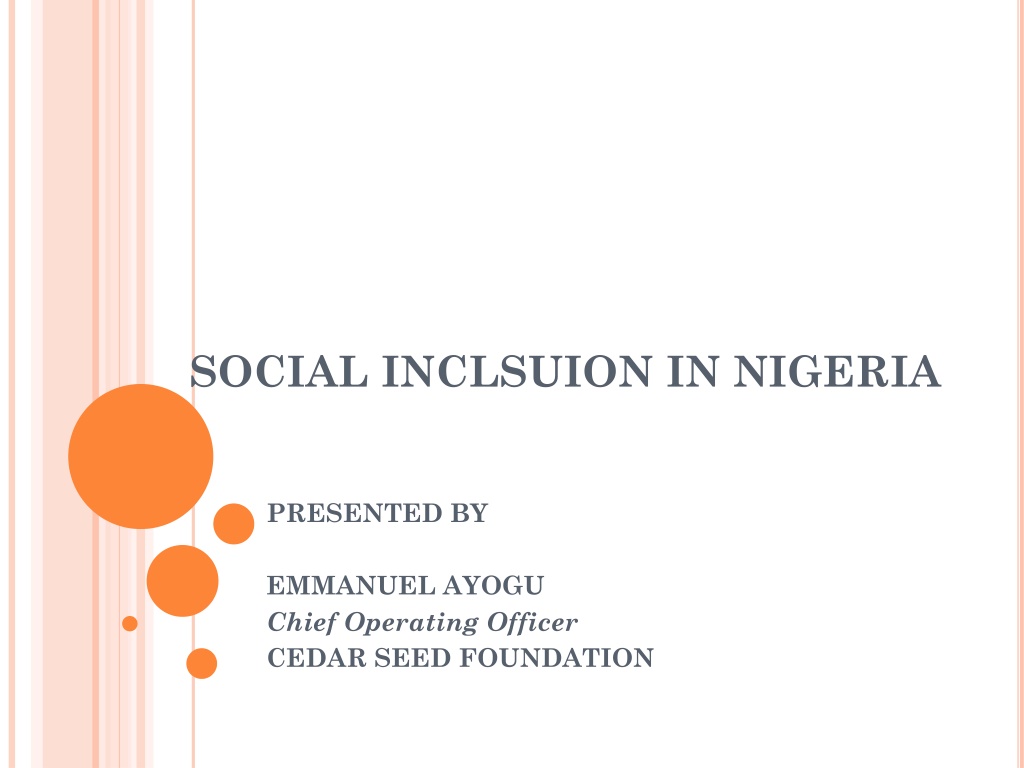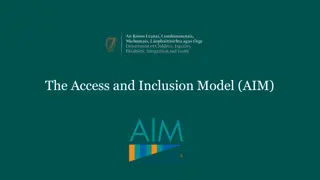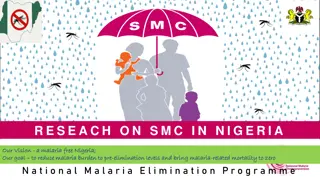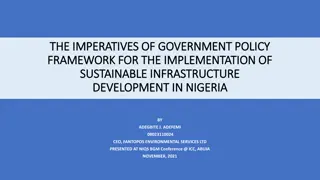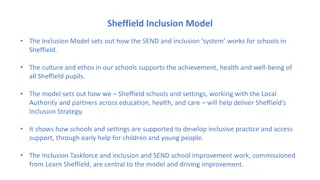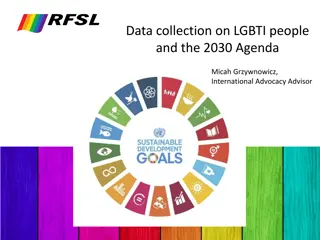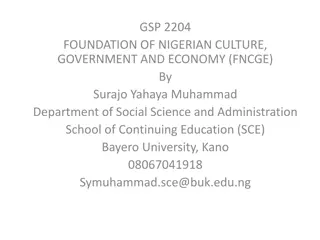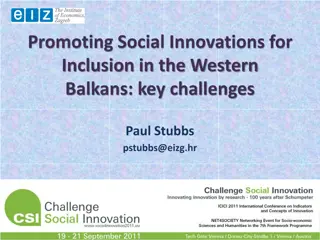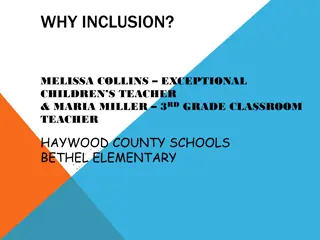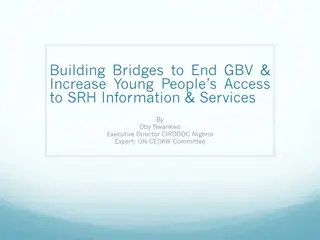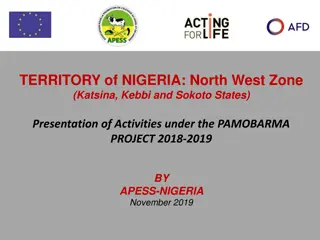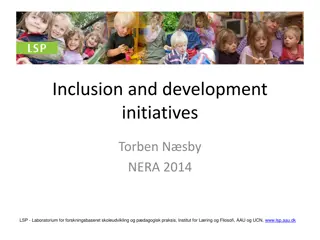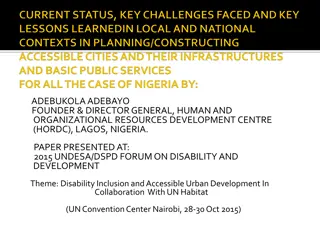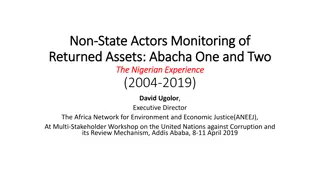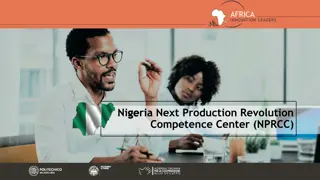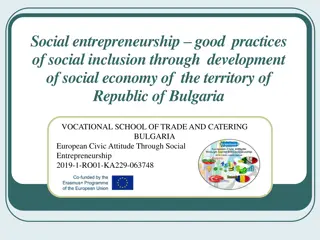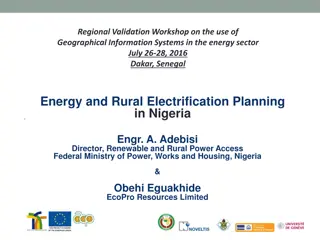Enhancing Social Inclusion for a Diverse Society: A Focus on Nigeria
The concept of social inclusion as a key goal of development was emphasized at the World Summit for Social Development in 1995. It aims to ensure equal opportunities for all individuals to actively participate in various aspects of society, combatting poverty and exclusion. Social exclusion, on the other hand, refers to barriers that hinder full participation based on identity or disadvantages. This multidimensional issue impacts different dimensions of life, leading to inequalities within societies. Addressing these challenges is crucial for creating a more inclusive and equitable society in Nigeria.
Download Presentation

Please find below an Image/Link to download the presentation.
The content on the website is provided AS IS for your information and personal use only. It may not be sold, licensed, or shared on other websites without obtaining consent from the author. Download presentation by click this link. If you encounter any issues during the download, it is possible that the publisher has removed the file from their server.
E N D
Presentation Transcript
SOCIAL INCLSUION IN NIGERIA PRESENTED BY EMMANUEL AYOGU Chief Operating Officer CEDAR SEED FOUNDATION
INTRODUCTION The World Summit for Social Development, held in March 1995, established the concept of social integration to create an inclusive society, a society for all , as one of the key goals of social development. The Copenhagen Program of Action, a key outcome of the Summit, pledged to make the eradication of poverty, full employment and social integration overriding objectives of development. Declaration and Social inclusion is a process by which efforts are made to ensure equal opportunities background, so that they can achieve their full potential in life. It is a multi-dimensional process aimed at creating conditions which enable full and active participation of every member of the society in all aspects of life, including civic, social, economic, and political participation in decision making processes. Social inclusion is understood as the process by which societies combat poverty and social exclusion. for all, regardless of their activities, as well as
INTRODUCTION CONT. Social inclusion is the process of improving the terms on which individuals and groups take part in society improving the ability, opportunity, and dignity of those disadvantaged on the basis of their identity World Bank The main point in this definition is the terms of relation and interaction of individuals and groups in societal life . When the terms of relation is bad such that there is a breakdown in interaction and power relation as a result of bias, prejudice and stigmatization exclusion of certain individuals and groups result. One recent UN definition describes social exclusion as: a state in which individuals are unable to participate fully in economic, social, political and cultural life, as well as the process leading to and sustaining such a state (United Nations, 2016, p. 18). then social
INTRO. CONTD Social exclusion is understood as the condition (barriers and process) that impede social inclusion. Social exclusion is a process through which individuals or groups are wholly or partially excluded from fully participating in all aspects of life of the society, in which they live, on the grounds of their social identities, such as age, gender, race, ethnicity, culture or language, and/or physical, economic, social disadvantages. Social exclusion may mean the lack of voice, lack of recognition, or lack of capacity for active participation. It may also mean exclusion from decent work, assets, land, opportunities, access to social services and/or political representation. Social exclusion is multidimensional and it encompasses social, political, cultural and economic dimensions. It impacts on people in different ways over time, and it is the product of unequal power relations (Khan, et al., 2015, p. 3).
Social exclusion is more apparent in a socio- culturally and economic diverse society leading to inequalities within and among different segments and sections of the society. The current discussion on gender equity and social inclusion gives us an opportunity to examine Nigeria s level of gender inequality and social exclusion - in contemporary times - that have kept the greater proportion of Nigeria s population from participating fully and on an equal basis with everyone else in economic, social, political and cultural life. This discuss opportunity to examine and assess our actions and inactions that have helped to perpetuate this ugly trend of gender inequality and social exclusion in our society. presents us an
KEY QUESTIONS THAT WE MUST BEGIN TO ASK OURSELVES INCLUDE: Are we enablers of the marginalization and/or exclusion faced by women and girls; people with disabilities; ethnic and religious minorities; migrants and internally displaced people; children and younger people; older people; sexual minorities; people without official identification; and people living with HIV? How have our actions and/or inactions; our silence further entrenched societal bias against women and girls, and people with disabilities in the place of education, employment, business, politics, leadership and governance, in the socio-cultural and religious aspects of our societal life in Nigeria? What are we doing to reverse the current trend of social exclusion and how effective has these efforts been? Questions like these should constantly remind us that reducing gender inequality gap and creating a socially inclusive society in Nigeria is the responsibility of every one of us.
PERSPECTIVES TO SOCIAL INCLUSION Social inclusion, according to researchers in the field of special education, may be looked at in two distinct ways: personal perspective and public perspective. Personal perspective holds a subjective view on social inclusion. Here, Social acceptance. Social inclusion is about inclusion, as far as the personal perspective is concerned, is about self-assertiveness. It denotes knowing oneself despite physical, health, or sensory impairment. It means loving oneself and accepting oneself, without boasting and without apologies. Social inclusion is only humanely possible following acceptance. Only after self-conquest would we feel truly free and included. Social inclusion comes from the inside. inclusion is about total self-conquest. Social
PUBLIC PERSPECTIVE From the public perspective, Social inclusion is essentially about a tolerance. Disability inclusion, for the disabled, is having an unfettered opportunity to thrive and to maximize one's potential regardless of sensory or physical impairment. Social inclusion is seeing a government priority tilt to a plane that creates an enabling environment where everyone, regardless of gender, disability, ethnicity, location and/or health status can compete and succeed- with order, with fairness, and with justness. culture that embraces
SOCIAL EXCLUSION IN NIGERIA WHO IS EXCLUDED AND WHY? In Nigeria, there is agreement in literature that groups particularly at risk of social exclusion include: women and girls; people with disabilities; ethnic and religious minorities; migrants and internally displaced people; children and younger people; older people; sexual minorities; identification; and people living with HIV. people without official However, it is important to note the intersectional forms of exclusion that each of these groups face. The UNDP notes, for example, that women and young people are often victims of multiple and interlocking forms of discrimination and exclusion that can lead to an imbalance of power that excludes them from participating in economic development and affairs that affect them, ultimately undermining their needs and aspirations (2018, p. 26). For each of these groups, social exclusion is experienced as a result of complex and intersectional factors that combine to reduce their participation in society.
WOMEN AND GIRLS Women and girls face a range of formal and informal barriers to social inclusion. Gender inequality and discrimination against women and girls in Nigeria is a well-recognized cause of social exclusion. Nigeria ranks 139 out of 156 countries in the Gender Equality Index (World Bank, 2021, p. 20). The barriers against women and girls arise from a combination of restricted access to employment, education, health services, legal rights and public participation, and gendered social norms that position women and girls as wives and caretakers while men and boys are breadwinners and decision makers. 37 percent of women are not involved in decisions about their own health care, household purchases and visits to family or friends, and only 22 per cent of women have a bank account (NPC, 2019 p. 383-4). Following the 2019 elections, women make up 7.3 percent of the Nigerian Senate and 3.1 percent of the House of Representatives. No state governors are women (Kelly, 2019, p. 4). Many women and girls find it difficult to access vital and basic services.
PEOPLE WITH DISABILITIES with disabilities attitudinal, environmental and institutional barriers to social inclusion (Wapling, combination of formal barriers adjustments are not made and services and opportunities are not accessible) and informal barriers (arising from discriminatory attitudes and exclusionary practices). People with disabilities are disproportionately affected by poverty in Nigeria, with nine out of ten living below the poverty level (Thompson, 2019a, p. 6). Rates of youth unemployment for people with disabilities are 77.3 percent, compared with 49.2 percent for people without a disability. The adult unemployment rate is 62.5 percent for people with disabilities compared to 21.5 percent for those without disabilities. Women with disabilities are more likely to be unemployed than men (Thompson, 2019a, p. 5). People in Nigeria face a range of 2019). This includes mean a (which that
One recent study suggests that only 36 percent of children and young people with disabilities in Nigeria are literate (Holden et al., 2019; Wapling, 2019). The participation rate in education is 12 percent for children with disabilities, compared with 57 percent for those without disabilities. While those children with disabilities who are in school have good primary completion rates, JONAPWD estimates that 90 percent of children with disabilities are out of school in Nigeria (Thompson, 2019a). Barriers to education for people with disabilities include long and difficult journeys to school, poverty and school fees, negative attitudes and stigma, inaccessible infrastructure and lack of support services and professionals (Thompson, 2019a). Access to health care is another area where people with disabilities in Nigeria face barriers. This is particularly acute in certain areas such as reproductive health and mental health services (Holden et al., 2019). physiotherapy, sexual and
Inadequate access to transport and public buildings is another barrier faced by people with disabilities. Up to 80 percent of people with disabilities in Nigeria are reliant on public transport, yet vehicle design and road environments prevent public transport being accessible. Public buildings rarely have ramps or lifts, creating further barriers for people with disabilities trying to access services (Thompson, 2019a, p. 22). Conflict and violence in parts of Nigeria are thought to be both contributing to the disability prevalence rate, and further marginalizing people with disabilities, especially women and children (Holden et al., 2019). Stigma, discrimination and negative attitudes toward people with disabilities are a major cause of social exclusion in Nigeria. Intersecting with religious and cultural beliefs and superstitions, such negative attitudes lead to people with disabilities being seen as a burden or even a punishment or curse (Holden et al., 2019; Thompson, 2019a). People with mental health conditions and those in rural areas face heightened discrimination and stigma, as do women and girls with disabilities, who experience barriers on the grounds of both gender and disability (Jerry et al., 2015)
OTHER VULNERABLE GROUPS Ethnic and religious identities are often intertwined in Nigeria, forming part of a complex pattern of social exclusion. Religious minorities experience social, political and economic exclusion, as a result of differences with and discrimination from other religious communities, and treatment by state and federal government. Horizontal inequalities by ethnic group remain persistent for wealth, access to public services and education. People classed as non-indigenes are prevented from owning land or standing in elections, and they face barriers in accessing education, social protection and public sector jobs. Internally displaced people (IDPs) in Nigeria face social exclusion, and particular groups of IDPs, such as women, children and people with vulnerable and can be victims of abuse by authorities. Other mobile communities in Nigeria facing social exclusion include pastoralists, migrant farmers and migrant fisher folk. disabilities are particularly
Children and young people, who cannot access education, health, and other basic services needed for their wellbeing and participation in society, are at significant risk of social exclusion. Young people particularly prone to economic and social exclusion; while a high proportion of this age group is literate; the group has the highest unemployment and inactivity rates. Older people in Nigeria more likely to experience exclusion in the form of isolation, poverty and lack of healthcare, particularly as traditional family structures decline Widows face discrimination and exclusion, including being dispossessed of property after their husband s death. People living with HIV and their families experience stigma and discrimination from individuals, communities and service providers, including unwillingness to treat people with HIV from healthcare workers. age 15-29 in Nigeria are
SOCIAL EXCLUSION ANDPOVERTY Social exclusion increases poverty by reducing groups access to vital services such as health, education and social protection, and to livelihood opportunities. At the same time, poverty increases social exclusion, when access costs to services such as user fees and transport fares, and opportunity costs such as foregone earnings of adults and children, mean that households cannot afford education and healthcare (DFID, 2015). Social exclusion is at the heart of Nigeria poor human capital development.
SOCIAL EXCLUSION AND CONFLICT Social exclusion is also a causal factor in conflict and instability, especially when exclusion is based on religion, ethnicity or language (Khan, et al., 2015, p. 34; DFID Nigeria, 2019). Differences between groups are not enough in themselves to cause conflict, but inequalities and exclusion can lead to violent mobilization (Khan, et al., 2015, p. 34). The feeling of being unequally treated can nurture excluded groups and individuals to identify more closely with their religious beliefs and can bring about insurgence, terrorism and violence (UNDP, 2018, p. 29). When particular groups of people are denied the opportunity to fully participate, or to have a voice in society, fractures and divisions arise. Social inclusion therefore goes hand in hand with social integration and social cohesion (United Nations, 2016, p. 21). Social exclusion can also be a consequence of conflict. Certain groups such as women and girls are often further marginalized due to conflict and instability, while refugees are marginalized in the place to which they move (Khan, et al., 2015, p. 36).
KEY ELEMENTS OF SOCIAL INCLUSION Social inclusion is the right thing to do, and it also makes good economic sense. To achieve an inclusive society for all, the following elements are crucial: Respect for all human rights, freedoms, and the rule of law Maintaining the security of all individuals and their living environment All members of society are able and motivated to participate in civic, social, economic and political activities The existence of a strong civil society is fundamental There must be universal access to public infrastructure and facilities There must be equal access to public information There must be Equity in the distribution of wealth and resources Tolerance for and appreciation of cultural diversity. Education and continuous public orientation.
